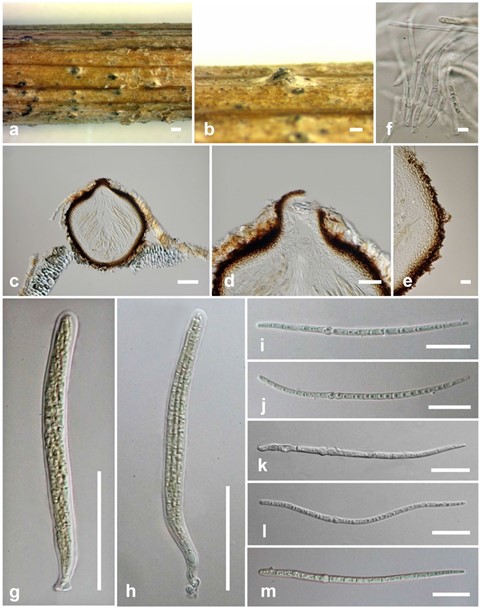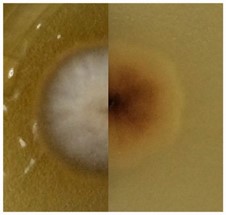Neoophiobolus chromolaenae Mapook & K.D. Hyde, sp. nov.
MycoBank number: MB 557344; Index Fungorum number: IF 557344; Facesoffungi number: FoF 07809; Fig. 61
Etymology: Name reflects the host genus Chromolaena, from which this species was isolated.
Holotype: MFLU 20-0335
Saprobic on dead stems of Chromolaena odorata. Sexual morph: Ascomata 230–400 µm high × 200–350 µm diam. ( x̄ = 323.5 × 296 µm, n = 5), immersed to semi-immersed, solitary, scattered, globose to subglobose, coriaceous, dark brown. Ostiole short papillate, with hyaline periphyses-like. Peridium 15–30 µm wide, comprising several layers of hyaline or pale brown to dark brown, pseudoparenchymatous cells, arranged in a textura angularis. Hamathecium comprising 1.5–2.5 µm wide, cylindrical to broadly filiform, septate, branching pseudoparaphyses, anastomosing above the asci. Asci (90–)100–135 × 8–13 µm (x̄ = 115 × 10 µm, n = 20), over-lapping, 8-spored, bitunicate, cylindrical to cylindric-clavate, straight or slightly curved, apically rounded, with ocular chamber visible when immature. Ascospores 85–110 × 2.5–3.5 µm ( x̄ = 97 × 3 µm, n = 20), fasciculate, in parallel, scolecosporous, hyaline to pale yellow brown, filiform, 10–20-septate with minute guttule in each cell, slightly curved, constricted at the central septum where the spore separates into two parts, with- out polar appendages. Asexual morph: Undetermined.
Culture characteristics: Ascospores germinating on MEA within 24 h. at room temperature and germ tubes produced from both ends. Colonies on MEA circular, mycelium slightly raised, moderately fluffy, entire to filamentous, cultures white at the surface, creamy-white in reverse with brown to dark brown from the centre of the colony (Fig. 62).
Pre-screening for antimicrobial activity: Neoophiobolus chromolaenae (MFLUCC 17-1467) showed no inhibition of E. coli, B. subtilis and M. plumbeus.
Material examined: THAILAND, Chiang Rai Province, Doi Mae Salong, on dead stems of Chromolaena odorata, 8 April 2017, A. Mapook (DMS4, MFLU 20-0335, holotype); ex-type culture MFLUCC 17-1467; Chiang Rai Province, Doi Pui, on dead stems of Chromolaena odorata, 5 August 2015, A. Mapook (DP42, MFLU 20-0336); living culture MFLUCC 17-1449.
GenBank numbers: LSU: MN994561, MN994562, ITS: MN994584, MN994585, SSU: MN994607, MN994608, TEF1: MN998165, MN998166
Notes: In a BLASTn search of NCBI GenBank, the closest match with the ITS and TEF1 sequences of Neoophiobolus chromolaenae (MFLUCC 17-1467, ex-holotype) with 99.31% (LT796836) and 99.16% (LT797076) similarity, respectively, was Trematophoma sp. strain UTHSC: DI16-210. The closest match with the LSU sequence with 99.12% similarity was Paraphoma fimeti (strain CBS 127796, MH876144), while the closest match with the SSU sequences with 96.89% similarity was Ophiosphaerella narmari (strain ATCC 64688, KC848510).

Fig. 61 Neoophiobolus chromolaenae (holotype) a, b Appearance of superficial ascomata on substrate. c Section through ascoma. d Ostiole. e Peridium. f Pseudoparaphyses. g, h Asci. i–m Ascospores. Scale bars: a = 500 µm, b = 200 µm, c = 100 µm, d, g, h = 50 µm, e, i–m = 20 µm, f = 5 µm

Fig. 62 Culture characteristic on MEA: Neoophiobolus chromolaenae (MFLUCC 17-1467)
